glove box TOYOTA YARIS 2021 Owners Manual
[x] Cancel search | Manufacturer: TOYOTA, Model Year: 2021, Model line: YARIS, Model: TOYOTA YARIS 2021Pages: 568, PDF Size: 110.34 MB
Page 125 of 568
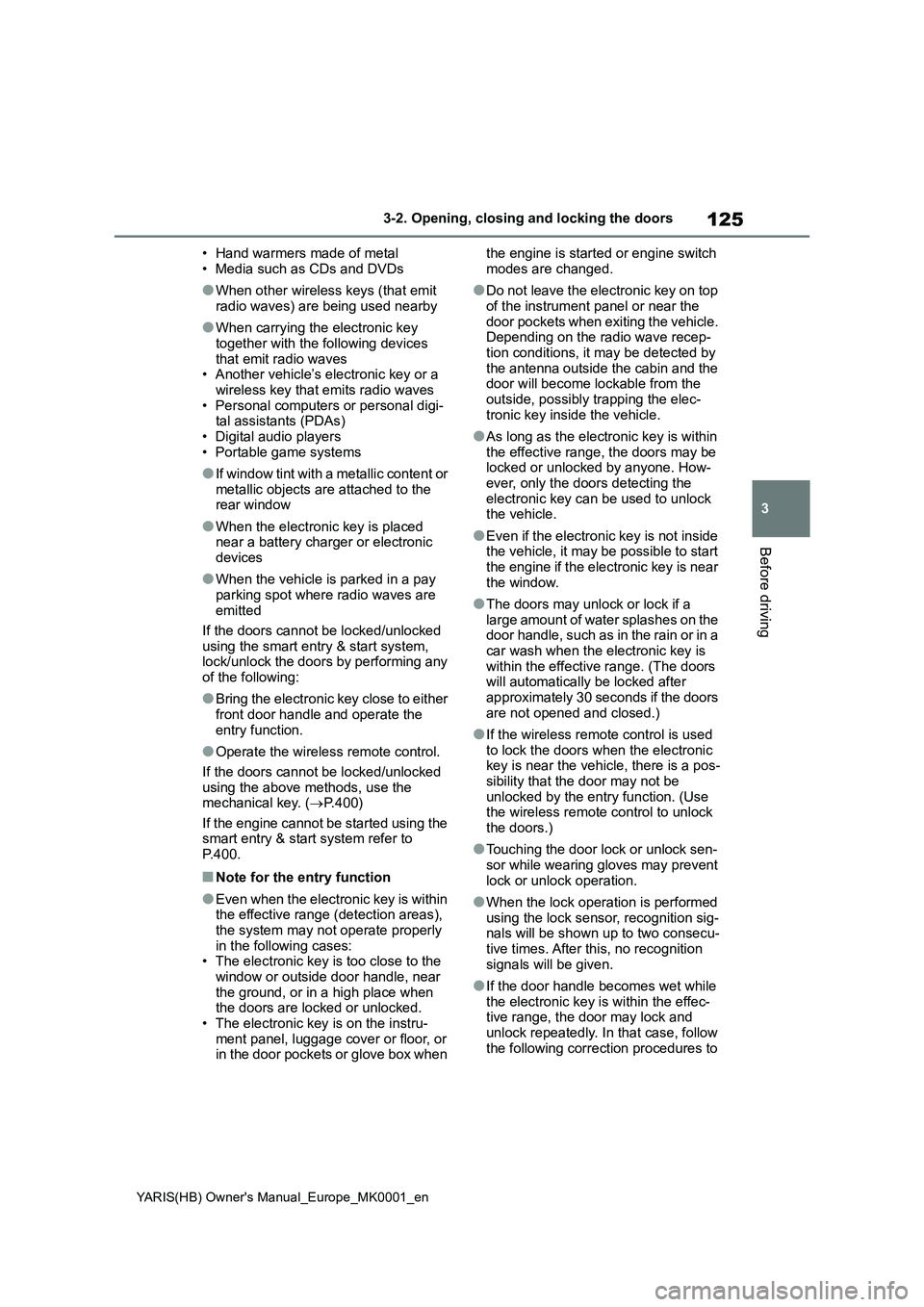
125
3
YARIS(HB) Owner's Manual_Europe_MK0001_en
3-2. Opening, closing and locking the doors
Before driving
• Hand warmers made of metal
• Media such as CDs and DVDs
●When other wireless keys (that emit
radio waves) are being used nearby
●When carrying the electronic key
together with the following devices
that emit radio waves
• Another vehicle’s electronic key or a
wireless key that emits radio waves
• Personal computers or personal digi-
tal assistants (PDAs)
• Digital audio players
• Portable game systems
●If window tint with a metallic content or
metallic objects are attached to the
rear window
●When the electronic key is placed
near a battery charger or electronic
devices
●When the vehicle is parked in a pay
parking spot where radio waves are
emitted
If the doors cannot be locked/unlocked
using the smart entry & start system,
lock/unlock the doors by performing any
of the following:
●Bring the electronic key close to either
front door handle and operate the
entry function.
●Operate the wireless remote control.
If the doors cannot be locked/unlocked
using the above methods, use the
mechanical key. (→P.400)
If the engine cannot be started using the
smart entry & start system refer to
P.400.
■Note for the entry function
●Even when the electronic key is within
the effective range (detection areas),
the system may not operate properly
in the following cases:
• The electronic key is too close to the
window or outside door handle, near
the ground, or in a high place when
the doors are locked or unlocked.
• The electronic key is on the instru-
ment panel, luggage cover or floor, or
in the door pockets or glove box when the engine is started or engine switch
modes are changed.
●Do not leave the electronic key on top
of the instrument panel or near the
door pockets when exiting the vehicle.
Depending on the radio wave recep-
tion conditions, it may be detected by
the antenna outside the cabin and the
door will become lockable from the
outside, possibly trapping the elec-
tronic key inside the vehicle.
●As long as the electronic key is within
the effective range, the doors may be
locked or unlocked by anyone. How-
ever, only the doors detecting the
electronic key can be used to unlock
the vehicle.
●Even if the electronic key is not inside
the vehicle, it may be possible to start
the engine if the electronic key is near
the window.
●The doors may unlock or lock if a
large amount of water splashes on the
door handle, such as in the rain or in a
car wash when the electronic key is
within the effective range. (The doors
will automatically be locked after
approximately 30 seconds if the doors
are not opened and closed.)
●If the wireless remote control is used
to lock the doors when the electronic
key is near the vehicle, there is a pos-
sibility that the door may not be
unlocked by the entry function. (Use
the wireless remote control to unlock
the doors.)
●Touching the door lock or unlock sen-
sor while wearing gloves may prevent
lock or unlock operation.
●When the lock operation is performed
using the lock sensor, recognition sig-
nals will be shown up to two consecu-
tive times. After this, no recognition
signals will be given.
●If the door handle becomes wet while
the electronic key is within the effec-
tive range, the door may lock and
unlock repeatedly. In that case, follow
the following correction procedures to
Page 148 of 568
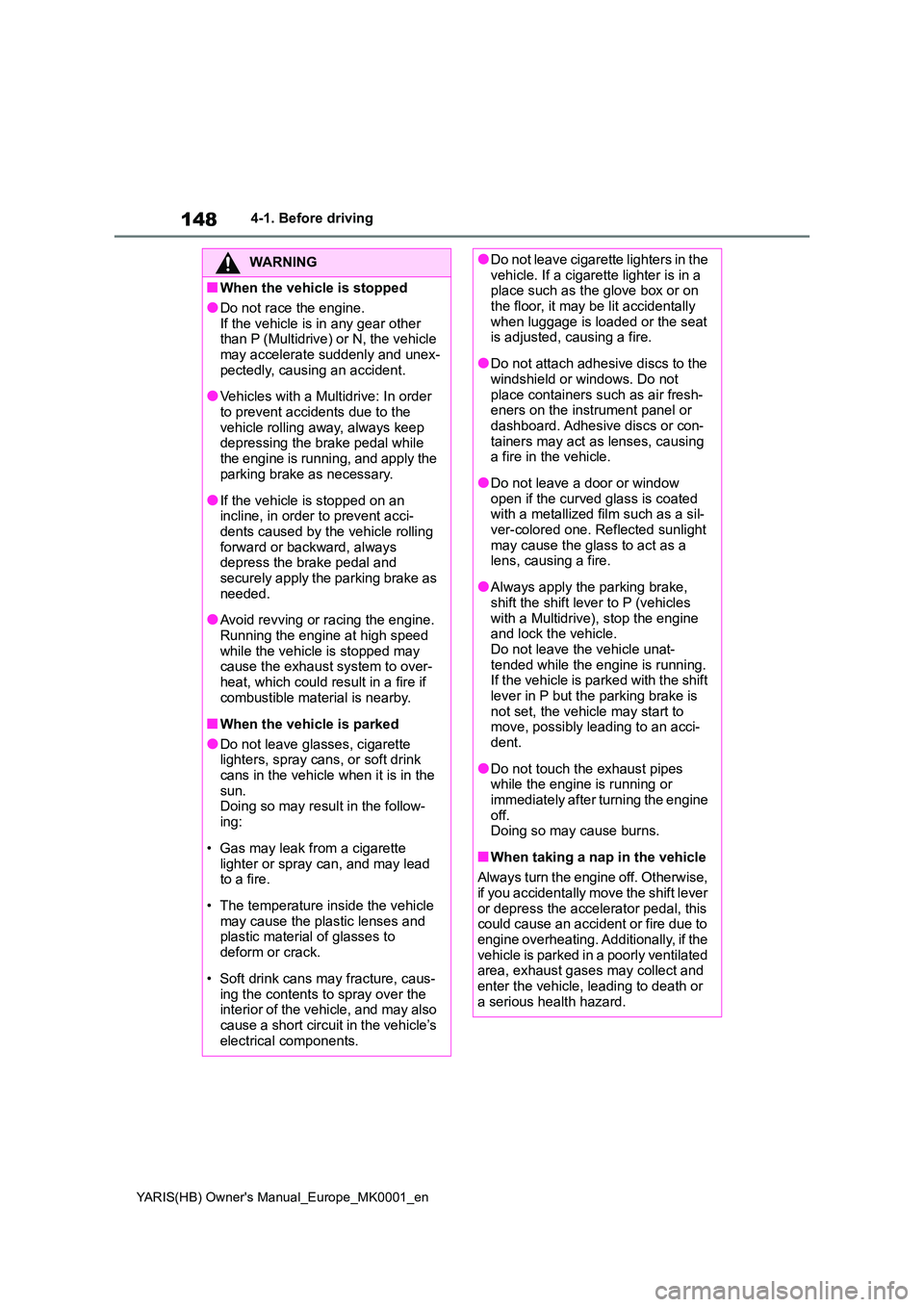
148
YARIS(HB) Owner's Manual_Europe_MK0001_en
4-1. Before driving
WARNING
■When the vehicle is stopped
●Do not race the engine.
If the vehicle is in any gear other than P (Multidrive) or N, the vehicle may accelerate suddenly and unex-
pectedly, causing an accident.
●Vehicles with a Multidrive: In order
to prevent accidents due to the vehicle rolling away, always keep depressing the brake pedal while
the engine is running, and apply the parking brake as necessary.
●If the vehicle is stopped on an incline, in order to prevent acci-dents caused by the vehicle rolling
forward or backward, always depress the brake pedal and securely apply the parking brake as
needed.
●Avoid revving or racing the engine.
Running the engine at high speed while the vehicle is stopped may cause the exhaust system to over-
heat, which could result in a fire if combustible material is nearby.
■When the vehicle is parked
●Do not leave glasses, cigarette lighters, spray cans, or soft drink
cans in the vehicle when it is in the sun.Doing so may result in the follow-
ing:
• Gas may leak from a cigarette
lighter or spray can, and may lead to a fire.
• The temperature inside the vehicle may cause the plastic lenses and plastic material of glasses to
deform or crack.
• Soft drink cans may fracture, caus-
ing the contents to spray over the interior of the vehicle, and may also cause a short circuit in the vehicle’s
electrical components.
●Do not leave cigarette lighters in the vehicle. If a cigarette lighter is in a place such as the glove box or on
the floor, it may be lit accidentally when luggage is loaded or the seat is adjusted, causing a fire.
●Do not attach adhesive discs to the windshield or windows. Do not
place containers such as air fresh- eners on the instrument panel or dashboard. Adhesive discs or con-
tainers may act as lenses, causing a fire in the vehicle.
●Do not leave a door or window open if the curved glass is coated with a metallized film such as a sil-
ver-colored one. Reflected sunlight may cause the glass to act as a lens, causing a fire.
●Always apply the parking brake, shift the shift lever to P (vehicles
with a Multidrive), stop the engine and lock the vehicle.Do not leave the vehicle unat-
tended while the engine is running. If the vehicle is parked with the shift lever in P but the parking brake is
not set, the vehicle may start to move, possibly leading to an acci-dent.
●Do not touch the exhaust pipes while the engine is running or
immediately after turning the engine off.Doing so may cause burns.
■When taking a nap in the vehicle
Always turn the engine off. Otherwise,
if you accidentally move the shift lever or depress the accelerator pedal, this could cause an accident or fire due to
engine overheating. Additionally, if the vehicle is parked in a poorly ventilated area, exhaust gases may collect and
enter the vehicle, leading to death or a serious health hazard.
Page 293 of 568
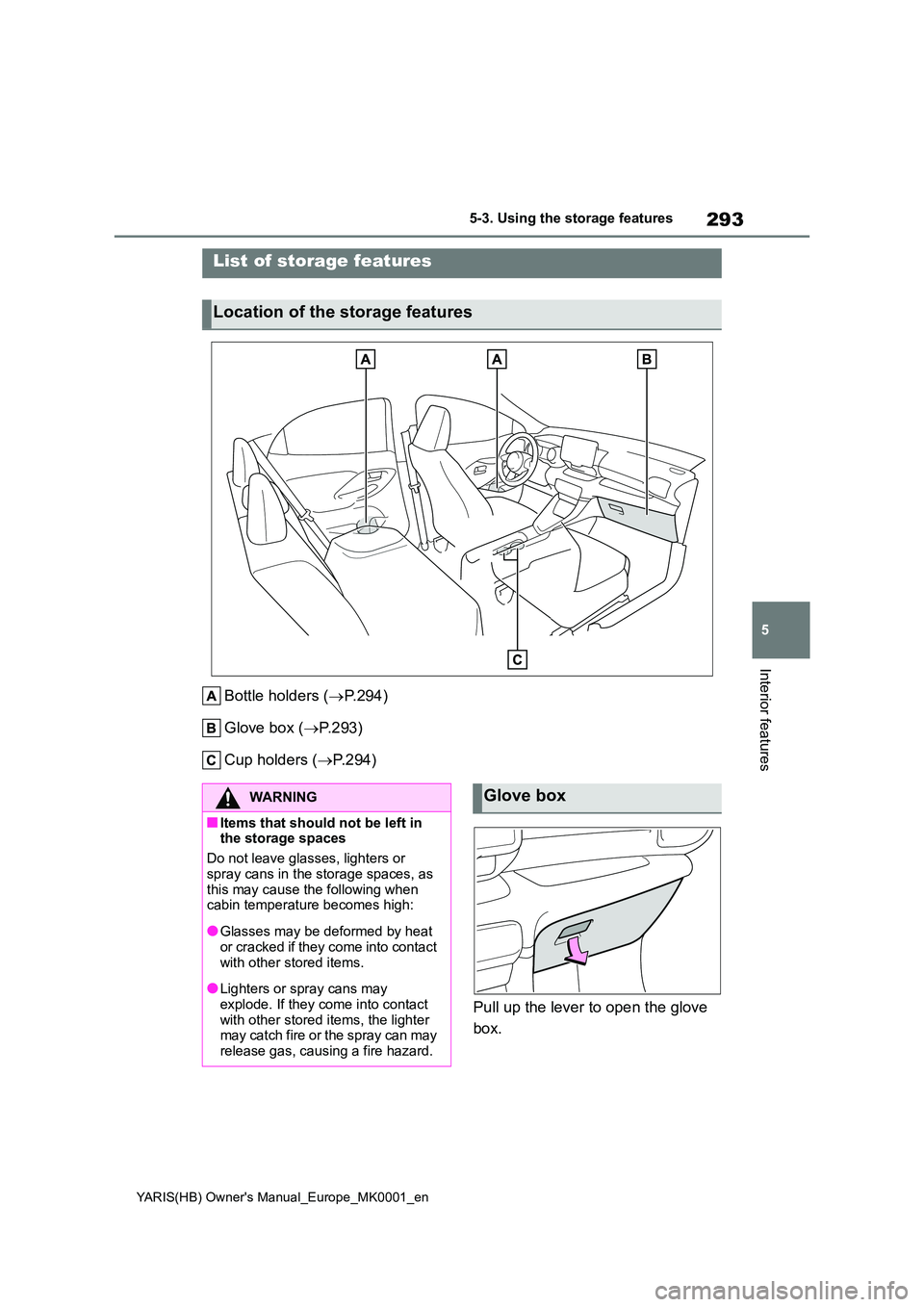
293
5
YARIS(HB) Owner's Manual_Europe_MK0001_en
5-3. Using the storage features
Interior features
5-3.Using the s torage feature s
Bottle holders (→P.294)
Glove box ( →P.293)
Cup holders ( →P.294)
Pull up the lever to open the glove
box.
List of storage features
Location of the storage features
WARNING
■Items that should not be left in the storage spaces
Do not leave glasses, lighters or
spray cans in the storage spaces, as this may cause the following when cabin temperature becomes high:
●Glasses may be deformed by heat or cracked if they come into contact
with other stored items.
●Lighters or spray cans may
explode. If they come into contact with other stored items, the lighter may catch fire or the spray can may
release gas, causing a fire hazard.
Glove box
Page 294 of 568
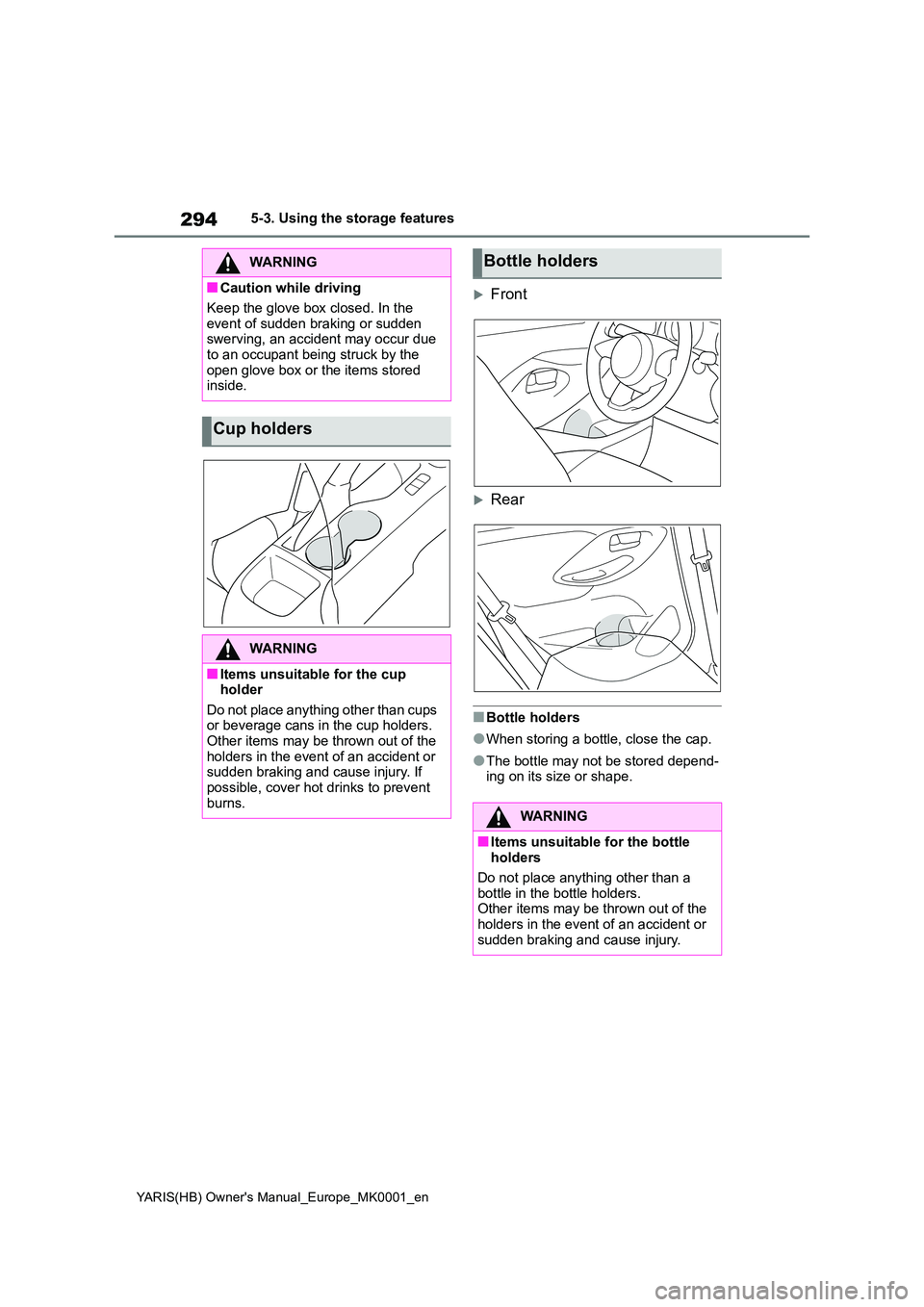
294
YARIS(HB) Owner's Manual_Europe_MK0001_en
5-3. Using the storage features
Front
Rear
■Bottle holders
●When storing a bottle, close the cap.
●The bottle may not be stored depend- ing on its size or shape.
WARNING
■Caution while driving
Keep the glove box closed. In the
event of sudden braking or sudden swerving, an accident may occur due to an occupant being struck by the
open glove box or the items stored inside.
Cup holders
WARNING
■Items unsuitable for the cup holder
Do not place anything other than cups or beverage cans in the cup holders.Other items may be thrown out of the
holders in the event of an accident or sudden braking and cause injury. If possible, cover hot drinks to prevent
burns.
Bottle holders
WARNING
■Items unsuitable for the bottle holders
Do not place anything other than a
bottle in the bottle holders. Other items may be thrown out of the holders in the event of an accident or
sudden braking and cause injury.
Page 342 of 568

342
YARIS(HB) Owner's Manual_Europe_MK0001_en
6-3. Do-it-yourself maintenance
■When removing the wheel orna-
ment (vehicles with a wheel cap clip)
Remove the wheel ornament using the
wheel cap clip*.*: The wheel cap clip is installed in the
glove box. ( →P.293)
�zUse only Toyota wheel nuts and
wheel nut wrenches designed for
use with your aluminum wheels.
WARNING
■When replacing wheels
●Do not use wheels that are a differ- ent size from those recommended in the Owner’s Manual, as this may
result in a loss of handling control.
●Never use an inner tube in a leak-
ing wheel which is designed for a tubeless tire.Doing so may result in an accident,
causing death or serious injury.
■When installing the wheel nuts
●Be sure to install the wheel nuts with the tapered ends facing inward ( →P.394). Installing the nuts with
the tapered ends facing outward can cause the wheel to break and eventually cause the wheel to come
off while driving, which could lead to an accident resulting in death or serious injury.
●Never use oil or grease on the wheel bolts or wheel nuts.Oil and grease may cause the
wheel nuts to be excessively tight- ened, leading to bolt or disc wheel damage. In addition, the oil or
grease can cause the wheel nuts to loosen and the wheel may fall off, causing an accident and resulting in
death or serious injury. Remove any oil or grease from the wheel bolts or wheel nuts.
■Use of defective wheels prohib-ited
Do not use cracked or deformed wheels. Doing so could cause the tire to leak air during driving, possibly
causing an accident.
NOTICE
■Replacing tire pressure warning valves and transmitters
●Because tire repair or replacement may affect the tire pressure warning valves and transmitters, make sure
to have tires serviced by any autho- rized Toyota retailer or Toyota authorized repairer, or any reliable
repairer. In addition, make sure to purchase your tire pressure warn-ing valves and transmitters at any
authorized Toyota retailer or Toyota authorized repairer, or any reliable repairer.
●Ensure that only genuine Toyota wheels are used on your vehicle.
Tire pressure warning valves and transmitters may not work properly with non-genuine wheels.
Aluminum wheel precau-
tions (if equipped)
Page 343 of 568

343
6
YARIS(HB) Owner's Manual_Europe_MK0001_en
6-3. Do-it-yourself maintenance
Maintenance and care
�zWhen rotating, repairing or
changing your tires, check that
the wheel nuts are still tight after
driving 1600 km (1000 miles).
�zBe careful not to damage the
aluminum wheels when using
tire chains.
�zUse only Toyota genuine balance
weights or equivalent and a plas-
tic or rubber hammer when bal-
ancing your wheels.1Turn the engine switch off.
2Open the glove box. Slide off
the damper.
3Push in the glove box on the
vehicle’s outer side to discon-
nect the 2 claws. Then pull out
the glove box and disconnect
the lower claws.Air conditioning filter
The air conditioning filter must
be changed regularly to main-
tain air conditioning efficiency.
Removing the air condition-
ing filter
Page 344 of 568
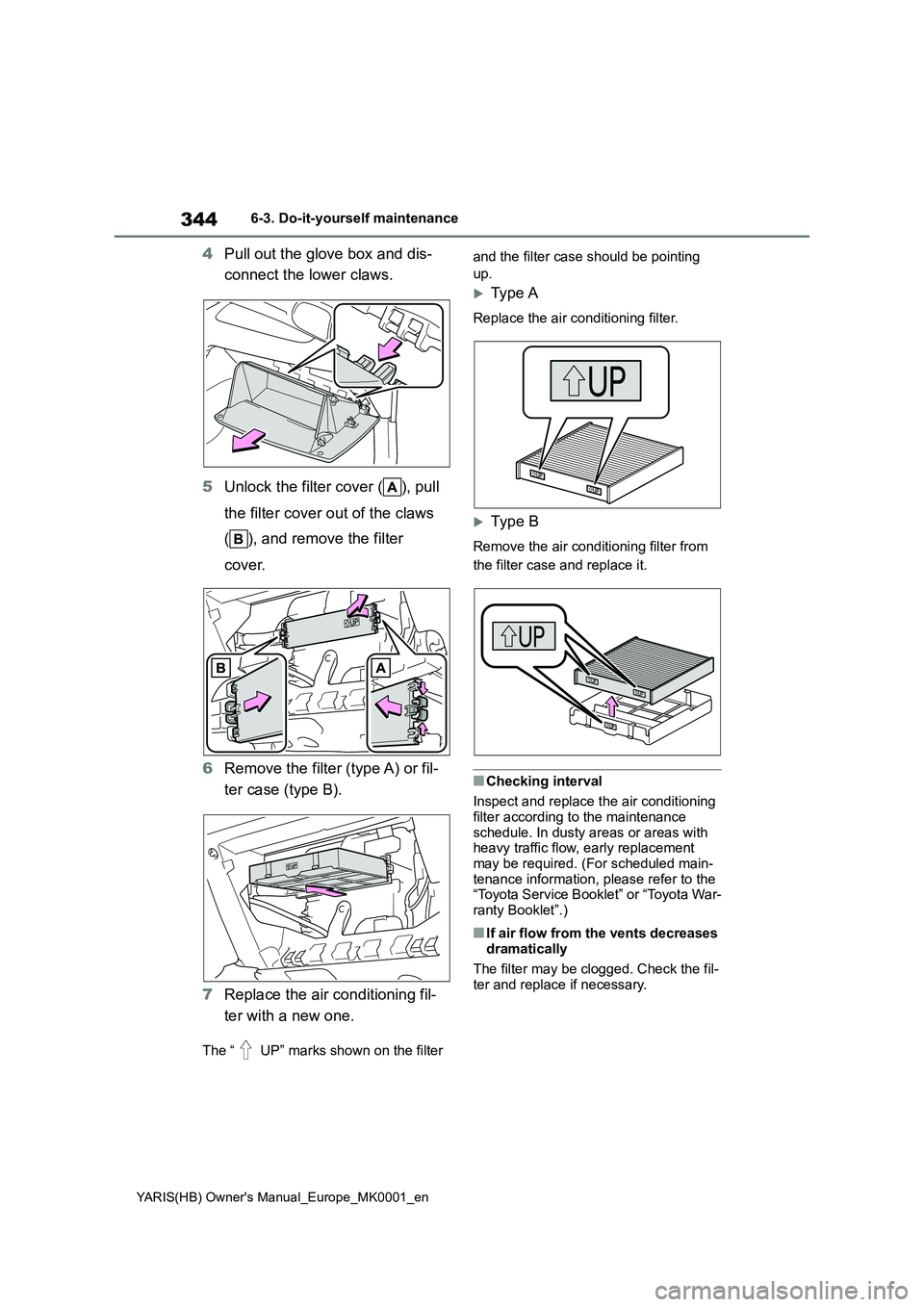
344
YARIS(HB) Owner's Manual_Europe_MK0001_en
6-3. Do-it-yourself maintenance
4Pull out the glove box and dis-
connect the lower claws.
5Unlock the filter cover ( ), pull
the filter cover out of the claws
( ), and remove the filter
cover.
6Remove the filter (type A) or fil-
ter case (type B).
7Replace the air conditioning fil-
ter with a new one.
The “ UP” marks shown on the filter and the filter case should be pointing
up.
Typ e A
Replace the air conditioning filter.
Typ e B
Remove the air conditioning filter from
the filter case and replace it.
■Checking interval
Inspect and replace the air conditioning
filter according to the maintenance
schedule. In dusty areas or areas with
heavy traffic flow, early replacement
may be required. (For scheduled main-
tenance information, please refer to the
“Toyota Service Booklet” or “Toyota War-
ranty Booklet”.)
■If air flow from the vents decreases
dramatically
The filter may be clogged. Check the fil-
ter and replace if necessary.
Page 558 of 568
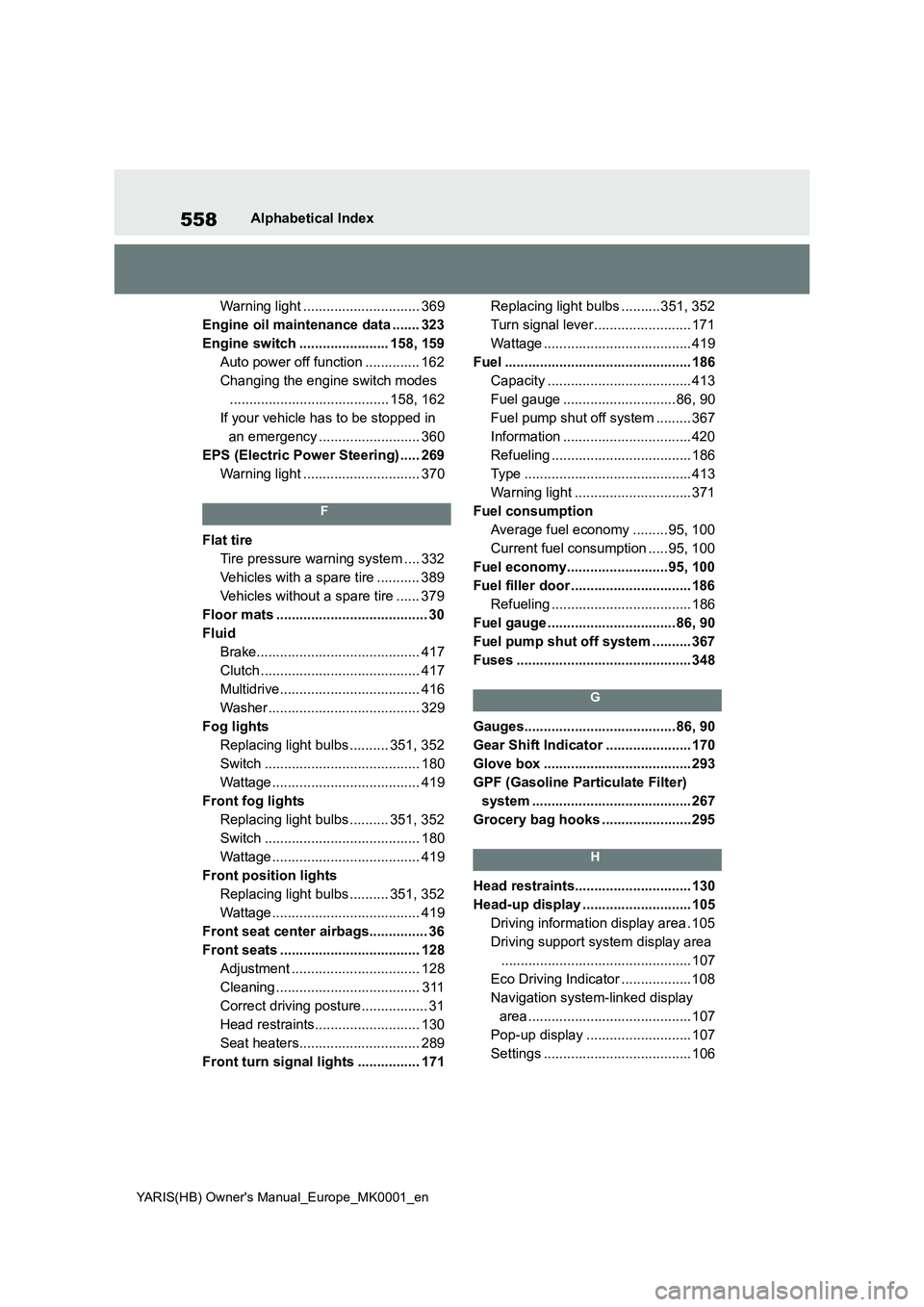
558
YARIS(HB) Owner's Manual_Europe_MK0001_en
Alphabetical Index
Warning light .............................. 369
Engine oil maintenance data ....... 323
Engine switch ....................... 158, 159
Auto power off function .............. 162
Changing the engine switch modes
......................................... 158, 162
If your vehicle has to be stopped in
an emergency .......................... 360
EPS (Electric Power Steering) ..... 269
Warning light .............................. 370
F
Flat tire
Tire pressure warning system .... 332
Vehicles with a spare tire ........... 389
Vehicles without a spare tire ...... 379
Floor mats ....................................... 30
Fluid
Brake.......................................... 417
Clutch ......................................... 417
Multidrive.................................... 416
Washer ....................................... 329
Fog lights
Replacing light bulbs .......... 351, 352
Switch ........................................ 180
Wattage ...................................... 419
Front fog lights
Replacing light bulbs .......... 351, 352
Switch ........................................ 180
Wattage ...................................... 419
Front position lights
Replacing light bulbs .......... 351, 352
Wattage ...................................... 419
Front seat center airbags............... 36
Front seats .................................... 128
Adjustment ................................. 128
Cleaning ..................................... 311
Correct driving posture................. 31
Head restraints........................... 130
Seat heaters............................... 289
Front turn signal lights ................ 171Replacing light bulbs ..........351, 352
Turn signal lever ......................... 171
Wattage ...................................... 419
Fuel ................................................ 186
Capacity ..................................... 413
Fuel gauge ............................. 86, 90
Fuel pump shut off system ......... 367
Information ................................. 420
Refueling .................................... 186
Type ........................................... 413
Warning light .............................. 371
Fuel consumption
Average fuel economy .........95, 100
Current fuel consumption .....95, 100
Fuel economy..........................95, 100
Fuel filler door ............................... 186
Refueling .................................... 186
Fuel gauge ................................. 86, 90
Fuel pump shut off system .......... 367
Fuses ............................................. 348
G
Gauges....................................... 86, 90
Gear Shift Indicator ...................... 170
Glove box ...................................... 293
GPF (Gasoline Particulate Filter)
system ......................................... 267
Grocery bag hooks .......................295
H
Head restraints.............................. 130
Head-up display ............................ 105
Driving information display area .105
Driving support system display area
................................................. 107
Eco Driving Indicator ..................108
Navigation system-linked display
area .......................................... 107
Pop-up display ........................... 107
Settings ...................................... 106